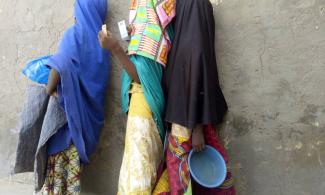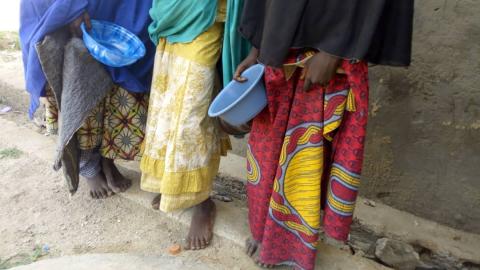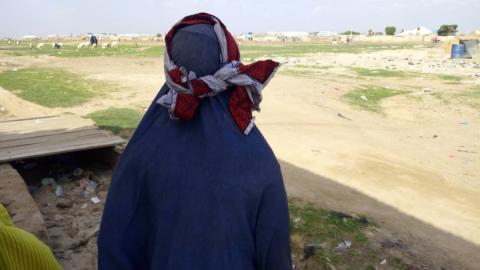
Thousands of children are orphaned due to the ongoing banditry in Zamfara State. These children are left on the street, without parental guidance and care. They have become a humanitarian crisis and if not addressed, might become an incubator for insurgency, writes BANJO DAMILOLA.

The sun was hot, burning through layers of clothes. Zamfara, a North-Eastern state in Nigeria, is notorious for its extreme weather. It was a blazing 38-degree Celsius but Larea and the other girls seem oblivious of the atmospheric condition. They have more pressing needs. They move from one stranger to the other with their bowl outstretched and their face solemn enough to extract empathy. The innocence of childhood has been tanned out of them.
Larea’s face rolled up in frowns that it was difficult to believe she was only 12 years old. She had grown up so suddenly, with the heavy burden of providing for herself and her aged grandmother. She fled her village, Sabon Birin Gobe, alone. Her father, Kadiri, who was a big-time tomato farmer, was killed and his corpse burnt by bandits. She does not know the whereabouts of her mother.
Larea’s mother could have been kidnapped or killed. She does not know. She has not seen her since everyone scampered out of the village months ago following an attack on the village by armed bandits.
Zamfara is one of the states affected by recurrent attacks by bandits. According to a United Nations report, at least 400 people have been killed and over 38,000 people displaced in Zamfara alone.
Women and children are particularly vulnerable to these attacks. While women are kidnapped, held in captivity and oftentimes raped, children are the casualties. They are left on their own, wandering with no parental care and struggling for survival.
Children as caregivers
There is no specific figure for the number of children, who have lost their parents from the ongoing banditry in the state. Kabiru Marafa, senator representing Zamfara Central, said not less than 44,000 children have become orphans in the last nine years of growing communal clash in the state. On the other hand, Abdulaziz Yari, a former governor of the state, puts the figure at 16,000.
Regardless of what the number is, there is a full-blown humanitarian crisis in the state. It is not uncommon in Zamfara State to find children within school age roaming about the street, begging for alms to feed themselves and sometimes carter for their older dependents, like Larea’s grandmother.
At Shosho Kwanu in Shinfafi Local Government Area where Larea lives, she pays the rent for a one-room apartment she shares with her grandmother.
“We pay N1000 as rent every month,” Larea said.
She raises the monthly rents from alms, and starving herself; feeding only to stay alive.
“I eat once a day. Sometimes, twice.” Larea added, looking down at her feet to conceal the embarrassment written on her face.
The United Nations Children's Fund said 15 million children— like Larea— under the age of 14 are involved in child labour.
According to a UNICEF fact sheet, many children are exposed to long hours of work in dangerous and unhealthy environments, carrying too much responsibility for their age. Working in these hazardous conditions with little food, small pay, no education, and no medical care establishes a cycle of child rights violations.
The raging violence
Banditry in Zamfara started out as a clash over resources between farmers and herdsmen. Although there is still a dimension of the struggle for land and water resources, the killings in Zamfara have become multifaceted.
Some security experts believe that there is an intrusion of armed militia from neighbouring countries, who simply seek to loot and kill. Captain Bish Johnson, a security expert, in an interview granted SaharaReporters in May 2019, said this armed militia is simply bloodthirsty. There are those who seem to think that the killings are a result of illegal mining. At least, the Nigerian Government, at a time, believed that was the problem. In April of this year, President Muhammed Buhari banned all mining activities in response to the killings and kidnappings in the state.
Despite this, killing and kidnapping continue to flourish. The death toll in Zamfara has risen above 100 since the ban. On May 28, barely a month after the government banned illegal mining, 23 people were killed on a single day in Kabaje villages, Kaura-Namoda Local Government Area, according to a report by the News Agency of Nigeria.
Three months after the ban, the Nigerian Army finally came to reason that mining was never the cause of the bloodletting that pervaded the whole of the North-Eastern region.
“We have other issues like the illegal crossing of borders from foreign lands. There are several conspiracies but the ultimate aim is to restore lasting peace in the region,” Onyema Nwachukwu, Nigeria’s chief military spokesperson, said.
Needless to say, this alluded lasting peace has remained elusive as men continue to get killed, women kidnapped and children left orphaned.
Hawau lost her father about eight months ago, about the same time the Nigerian Government had thought a ban on illegal mining would restore tranquillity to the state.
“When the bandits came,” Hawau said in Hausa. “They killed so many people. About 25 men were killed. My father and other relatives were killed.”
Hawau was reluctant to talk until she was sure a token would drop into the blue bowl she held in her hand. Khalid, who conducted the interview in Hausa, reached out into his pocket for an N20 note. It was not until then that Hawau became willing to answer some of the journalist’s questions.
The little girl, 10 years old, begs so she could feed and also help her mother. According to UNICEF, 13 per cent of children labourers engage in begging.

She comes out as early as 8:00am, about the same time people are setting out for work and opening stores, and goes back home around 6:00pm in the evening. It is particularly important for Hawau to be home to protect herself from sexual predators who seek the night as cover.
“I go home around 5:00pm or 6:00pm sometimes. Nobody has touched me anyhow,” she said looking away in such a way to suggest she considered the question embarrassing. However, child psychologists explained that children like Hauwau and Larea are prey to sexual predators.
A traumatised generation

Worse enough, these children have had to witness agonizing events. Hauwau saw as her father and relatives were axed to death. They are forced to live an adult life at an early age, exposed to extremely harsh living conditions and perpetually in lack. This way of living is a recipe for trauma, Isioma Chukwuka-Nwodo, a psychologist, said.
“Being abandoned—as these orphans are—is a kind of trauma for a child,” Chukwuka-Nwodo opined. “Not only are they exposed to the physical trauma of cold, not having clothes; exposed to rain, sun and all but psychologically as well.”
The absence of a nurturing environment endangers their psychological stability and has long-lasting effects. Lack of a nurturer destroys the children’s ability to empathize, love and feel loved.
“It is a vicious cycle, really,” she explained. “These children are unable to deal with frustration. A nurturing environment helps children check some frustration and react positively. A child raised in a love-filled environment understands that denial does not mean hatred.”
Conversely, a child who lacks this has a distorted view and internalizes negativity easily, the psychologist said.
The consequence of this, for these orphans, is that they become dangerous to themselves and society. They are easily recruited for criminal activities. In their early teens, except they receive appropriate care, they began to show signs of juvenile deliquesce, Chukwuka-Nwodo stated.
These orphans, abandoned and left to care for themselves, are likely to abuse substances. Drug abuse is prevalent in northern Nigeria. The high rate of substance abuse is not unconnected to pockets of violence in the region. A European Union-funded research found that 12 per cent of the Zamfara population abuse drugs in various forms.
Kadiri is unmistakably a teenager but the scaly, wrinkled skin around his feet made him seem much older. His lips were broken and dried out by the weather. He looked generally unkempt in his faded red shirt.
He sat in the midst of other teenage boys like himself. They all had wrapped Indian hemp in their hands. They did not want their pictures taken and would not speak to anyone.
“If you give us money, we will talk to you,” Kadiri said.
Children like Kadir and his group of friends are common in Gusau, the capital city of Zamfara State, where they engage in manual labour and, of course, abuse substances.
The government and international humanitarian organisation must respond swiftly to the crisis else these children would become ready recruits as insurgents, Murtala Abubakar, Project Coordinator of Arewa Research and Development Project, suggested.
“This number of orphans in Zamfara State alone is enormous. These children will become a problem for society and the world at large if they are not taken care of and the crisis ripping off their parents addressed. A stitch in time, save nine,” Abubakar said.